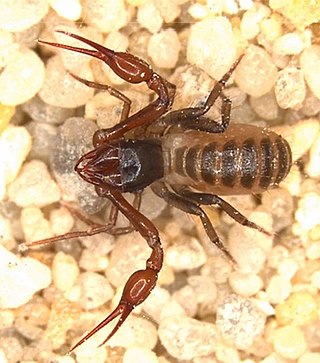
Pseudoscorpions, also known as false scorpions or book scorpions, are small, scorpion-like arachnids belonging to the order Pseudoscorpiones, also known as Pseudoscorpionida or Chelonethida.

Chthoniidae is a family of pseudoscorpions within the superfamily Chthonioidea. The family contains more than 600 species in about 30 genera. Fossil species are known from Baltic, Dominican, and Burmese amber. Chthoniidae now includes the former families Tridenchthoniidae, and Lechytiidae which has been demoted to subfamilies.
Pseudotyrannochthonius silvestrii is a species of Chilean pseudoscorpions of the family Pseudotyrannochthoniidae. It was described in 1905 by Edvard Ellingsen, with a type locality of Santiago, Chile.

Neobisiidae is a family of pseudoscorpions distributed throughout Africa, the Americas and Eurasia and consist of 748 species in 34 genera. Some species live in caves while some are surface-dwelling.
Chitrella regina is a species of pseudoscorpions in the family Syarinidae.

Pseudotyrannochthoniidae is a family of pseudoscorpions, belonging to the superfamily Chthonioidea. It represents the most basal and primitive group of living pseudoscorpions, with less than 100 species in 6 genera. Living members of the group have a strongly disjunct distribution, likely reflecting ancient vicariance, occurring in Australia, Asia, Southern Africa and Madagascar, Western North America and southern South America. Fossils species are known from the Eocene Baltic and Bitterfeld amber, which represent members of extant Asian genera.
Sathrochthonius is a genus of pseudoscorpions in the family Chthoniidae. It was described in 1962 by American arachnologist Joseph Conrad Chamberlin.
Sathrochthonius tuena is a species of pseudoscorpion in the Chthoniidae family. It is endemic to Australia. It was described in 1962 by American arachnologist Joseph Conrad Chamberlin.

Pseudotyrannochthonius is a genus of pseudoscorpions in the family Pseudotyrannochthoniidae. It was described in 1930 by Austrian arachnologist Max Beier.
Pseudotyrannochthonius solitarius is a species of pseudoscorpion in the Pseudotyrannochthoniidae family. It is endemic to Australia. It was described in 1951 by American arachnologist Clarence Clayton Hoff.
Pseudotyrannochthonius tasmanicus is a species of pseudoscorpion in the Pseudotyrannochthoniidae family. It is endemic to Australia. It was described in 1970 by Australian zoologist Alan Dartnall.
Pseudotyrannochthonius typhlus is a species of pseudoscorpion in the Pseudotyrannochthoniidae family. It is endemic to Australia. It was described in 1970 by Australian zoologist Alan Dartnall.
Pseudotyrannochthonius australiensis is a species of pseudoscorpion in the Pseudotyrannochthoniidae family. It is endemic to Australia. It was described in 1966 by Austrian arachnologist Max Beier.
Pseudotyrannochthonius bornemisszai is a species of pseudoscorpion in the Pseudotyrannochthoniidae family. It is endemic to Australia. It was described in 1966 by Austrian arachnologist Max Beier.
Pseudotyrannochthonius hamiltonsmithi is a species of pseudoscorpion in the Pseudotyrannochthoniidae family. It is endemic to Australia. It was described in 1968 by Austrian arachnologist Max Beier.
Pseudotyrannochthonius gigas is a species of pseudoscorpion in the Pseudotyrannochthoniidae family. It is endemic to Australia. It was described in 1969 by Austrian arachnologist Max Beier.

Pseudotyrannochthonius giganteus is a species of pseudoscorpion in the Pseudotyrannochthoniidae family. It is endemic to Australia. It was described in 1971 by Austrian arachnologist Max Beier.
Pseudotyrannochthonius eberhardi is a species of pseudoscorpion in the Pseudotyrannochthoniidae family. It is endemic to Australia. It was described in 1971 by arachnologists Danilo Harms and Mark Harvey. The specific epithet eberhardi honours Stefan Eberhard, who collected the holotype, for contributions to Australian karst research.

Parobisium is a genus of pseudoscorpions in the family Neobisiidae.




